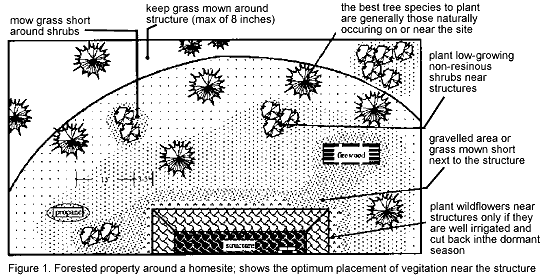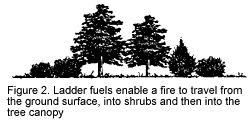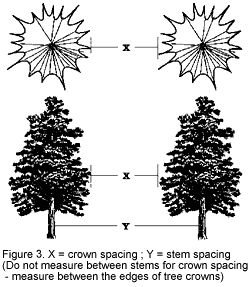Quick
Facts
|
Introduction
Colorado's population is growing, its urban areas are rapidly expanding, and more and more homes are being built in what was once natural forest. Those who move to rural areas often are misinformed about how to correctly landscape their property.
Improper landscaping worries land managers and fire officials because it can greatly increase the risk of structure and property damage from wildfire. The concern increases when one realizes that it is a question of when, not if, a wildfire will strike in any particular area.
Vegetative clearance around the house (defensible space) is the primary determinant of a home's ability to survive wildfire. Defensible space is, simply, "room" for fire-fighters to do their job. If grasses, brush, trees, and other common forest fuels are removed, reduced, or modified to lessen a fire's intensity and keep it away from the home, chances increase that the structure will survive (see Figure 1). Development of defensible space is outlined in Service in Action 6.302, Creating fire-safe zones around your forested homesite.

Colorado has great diversity in climate, geology, and vegetation. Homesites and cabins can be found from the foothills through 10,000 foot elevations. Such extremes present a challenge in the development of species recommendations for multiple vegetative zones. While native plant materials are generally best, a wide range of species can be grown successfully in Colorado. Recommended plants are listed in Service in Action 7.201, Grass planting tips for mountain communities; 7.406, Garden flower for mountain communities; 7.407, Shrubs for mountain communities; 7.408, Trees for mountain communities; and 7.413, Groundcover plants for mountain communities (excluding grasses).
Most of these species can be used for landscaping in defensible space if restraint and common sense are used and consideration is given to plant arrangement and maintenance. Consider the following factors when landscaping within the defensible space.
Grasses
| Table 1. Genesee Fire Control Seed Mix. | |
| Grass | % by weight |
|---|---|
| Crested wheatgrass 'Ephriam' | 40 |
| Buffalograss, TREATED seed | 30 |
| Arizona fescue 'Redono' | 13 |
| Hard fescue 'Durar' | 13 |
| Blue grama 'Lovington' | 2 |
| Sideoats grama 'Vaughn' or 'Butte' | 2 |
| Sow at 15 pounds pure live seed/acre, or .5 to 1 pound pure live seed per 1000 sq. ft. Rake seed in following sowing. | |
A "fire safe" seed mix, developed by the Genesee Forestry Committee (a homeowner group in the foothills west of Denver), creates a relatively dense, low-growing, hardy, and easy-to-maintain turf (see Table 1). The mixture has been used successfully for several years. (Contact your local Soil Conservation Service office or district office of the Colorado State Forest Service for information on seed mixes for your particular area.)
Mow grasses low around the house and garage, as well as around out buildings, decks, firewood piles, propane tanks, shrubs, and specimen trees with low-growing branches.
Wildflowers
Wildflowers bring variety to a landscape and can provide color from May until frost. Wildflower beds give a natural appearance to the otherwise manicured look often resulting from defensible space development. (See Service in Action 7.233, Wildflowers for Colorado landscapes.) A concern with wildflowers is the tall, dense areas of available fuel they can form, especially in dormancy. Plant wildflowers in widely separated beds within the defensible space to mitigate fire hazard. Do not plant directly adjacent to structures unless the beds are frequently irrigated and vegetation promptly removed after the first hard frost. Use gravel walkways, rock retaining walls, or irrigated grass areas mowed to a low height to isolate wildflower beds from each other and from other fuels.
Shrubs
 Shrubs lend color and variety to the landscape in addition
to providing cover and food for wildlife. (See Service in
Action 7.407, Shrubs for mountain communities). However, shrubs
concern fire professionals because, as the next level in the
"fuel continuum," they can add significantly to total fuel
loading. They are a potential source of fire brands which,
when carried in the smoke column ahead of the main fire, can
rapidly spread the fire in a phenomenon known as "spotting."
Shrubs lend color and variety to the landscape in addition
to providing cover and food for wildlife. (See Service in
Action 7.407, Shrubs for mountain communities). However, shrubs
concern fire professionals because, as the next level in the
"fuel continuum," they can add significantly to total fuel
loading. They are a potential source of fire brands which,
when carried in the smoke column ahead of the main fire, can
rapidly spread the fire in a phenomenon known as "spotting."
But the primary concern with shrubs is that they are a "ladder fuel"--they can carry a relatively easy-to-control surface fire into tree crowns. Crown fires are very difficult, indeed, sometimes impossible, to control (see Figure 2). To reduce the fire spreading potential of shrubs, plant low-growing, non-resinous varieties close to structures. (Recommended plants are listed in Service in Action 7.201, 7.406, 7.407, 7.408, 7.413.) Do not plant directly beneath windows or vents, or where they might spread under wooden decks. Do not plant shrubs under tree crowns, or use them to screen propane tanks, firewood piles, or other flammable materials. Plant shrubs individually, as specimens, or in small clumps apart from each other, and away from any trees within the defensible space.
Mow grasses low around shrubs. Prune dead stems from shrubs annually and remove the lower branches and suckers from species such as Gambel oak to "raise the canopy" away from possible surface fires. (See Service in Action 7.205, Pruning evergreens; 7.206, Pruning techniques for shrubs; and 7.207, Pruning deciduous trees, for proper pruning techniques.)
Trees
Trees provide a large amount of available fuel for a fire and can be a significant source of fire brands if they do burn. Burning trees give off a large amount of radiant heat that can ignite nearby shrubs, trees, or structures.
Colorado's elevation and temperature extremes limit tree species selection. The best species to plant are generally those that are already growing on or near the site, but others may be planted if care and common sense are used. (See Service in Action 7.408, Trees for mountain communities, for species lists.)
If your
site receives enough moisture to grow them, plant deciduous
trees such as aspen or narrowleaf cottonwood. These species,
even when planted in dense clumps, generally will not burn
well, if at all. The greatest problem with these trees is
the accumulation of dead leaves in the fall; remove accumulations
close to structures as soon as possible after  leaf drop.
leaf drop.
When site and/or moisture availability limits recommended species to evergreens, carefully consider their placement. Do not plant trees near structures. Allow plenty of room between trees, and consider the growth potential of each species. Spacing within the defensible space should be at least 10 feet between the edges of tree crowns (see Figure 3). Plant smaller trees initially on a 20- to 25-foot spacing to allow for tree growth. At some future point, it may be necessary to thin your trees t retain proper spacing.
Prune the branches of the trees as they grow (and those of any existing trees on the site) up to a height of 10 feet above the ground. Do not over-prune the crowns of smaller trees.
Some trees (for example, blue spruce) tend to keep a full crown; trees grown in the open may exhibit a full growth habit. Limit the number of trees of this type within the defensible space. Prune others as described above, and mow grasses around such specimen trees.
Publication #: 6.303
Cooperative Extension, Colorado State University. Published
September 1993. Copyright 1993. This Service in Action sheet
was produced in cooperation with the Colorado State Forest Service.
Some recommendations change regularly; contact your county Cooperative
Extension office or local State Forest Service office for current
recommendations or further information.
Frank C. Dennis, District Forester, Colorado State Forest Service.
Disclaimer and Reproduction Information: Information in NASD does not represent NIOSH policy. Information included in NASD appears by permission of the author and/or copyright holder. More